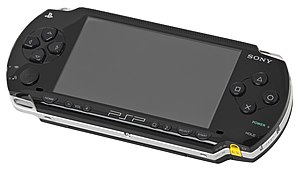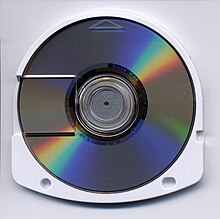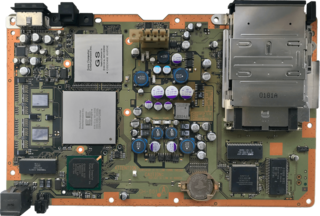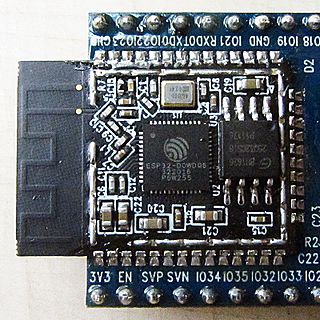
The PlayStation Portable's hardware consists of the physical components of the PlayStation Portable (PSP) and its accessories.

The PlayStation Portable's hardware consists of the physical components of the PlayStation Portable (PSP) and its accessories.
The PSP was designed by Shin'ichi Ogasawara (小笠原伸一) for the Sony Computer Entertainment subsidiary of Sony Corporation. Early models pre-installed with 1.xx firmware were made in Japan but in order to cut costs, Sony has farmed out PSP production to non-Japanese manufacturers, mainly in China for units pre-installed with firmware version 2.00 and above. The unit measures 170 mm (6.7 inches) in length, 74 mm (2.9 inches) in width, and 23 mm (0.9 inches) in depth, and has a mass of 280 grams (9.9 oz or 0.62 lb) including the battery. The Samsung (previously Sharp) branded TFT LCD screen measures 110 mm (4.3 in) diagonal with a 16:9 ratio and a 480×272 pixel resolution capable of 16.77 million colors and has a brightness of up to 115 (battery powered) or 148 cd/m2 (AC powered). [1] It has four possible brightness settings, the brightest of which is disabled in all official firmware versions unless on A/C power. Additionally, hidden brightness settings can be enabled when using Custom Firmware.
The PSP uses a drive compatible with Sony's proprietary Universal Media Disc format. Use of the drive increases battery drain by approximately 10% and the system has been criticized for having very slow data transfer speeds, translating into load times of more than two minutes in total for some games. However this has been improved with the redesigned Slim & Lite PSP which has faster loading times, according to GameSpot's "Sony PSP Slim Hands-On Report".
Despite its movie and music playback capabilities, the PSP has primarily gaming-oriented controls (as opposed to the controls typical to television remotes or MP3 players): two shoulder buttons (L and R), the PlayStation, start and select buttons, a digital 4-directional pad, and an analog 'nub' which is slid rather than tilted. There is also a row of secondary controls along the underside of the screen, for controlling volume, music settings (either switching the audio off and on in games or selecting different equalizer presets), screen brightness, and a "Home" button for accessing the system's main menu. Pressing the Home button while doing anything except playing a game will bring up the XMB, which theoretically allows for multitasking; however whatever the user was doing is cancelled upon accessing anything else, except in the latest firmware release that can display pictures and play music simultaneously.
The PSP's default battery life varies widely depending on application from less than 3 hours while accessing a wireless network and having screen brightness on its highest setting to more than 11 hours during MP3 playback with the screen turned off. [2] An extended-life 2200 mAh battery will increase this by approximately 20%. A sleep mode is also available that uses minimal battery power to keep the system's RAM active, allowing for "instant on" functionality. A system in sleep mode (with a fully charged battery) has been shown to lose an average of only 1% battery life per 24-hour period. The PSP-1000 series is equipped with a two-pin docking connector immediately below the AC adapter jack for easy drop in charging using a docking station that was to be sold separately. However no such dock was ever released by Sony, and therefore are absent from the PSP-2000 and later versions.
On October 1, 2009 (November 1 in Japan) Sony released the PSP Go, a redesigned version of the PSP. The PSP Go features a sliding design, allowing the screen to slide up past the main controls. The PSP Go lacks a UMD drive, instead containing 16GB of internal memory on which games are stored.

The PSP's main microprocessor is a multifunction device named "Allegrex" that includes a 32-bit MIPS32 R4k-based CPU (Little Endian), a Floating Point Unit, and a Vector Floating Point Unit. Additionally, there is a processor block known as "Media Engine" that contains another 32-bit MIPS32 R4k-base CPU, hardware for multimedia decoding (such as H.264), and a programmable DSP dubbed "Virtual Mobile Engine". The secondary CPU present in the Media Engine is functionally equivalent to the primary CPU save for a lack of a VPU. The MIPS CPU cores are globally clocked between 1 and 333 MHz. During the 2005 GDC, Sony revealed that it had capped the PSP's CPU clock speed at 222 MHz for licensed software. Its reasons for doing so are unknown, but are the subject of some speculation (e.g. to keep power consumption and heating low). Various homebrew tools enable users to operate at 333 MHz, generally leading to a higher frame rate at the expense of battery life. On June 22, 2007, Sony Computer Entertainment confirmed that the firmware version 3.50 does in fact remove this restriction and allows future games to run at the full 333 MHz speed. It does not affect already-released games. [3]
The system has 32 MiB main RAM in the original PSP and 64 MiB in the PSP 2000 (and subsequent series) and 4 MiB embedded DRAM in all models. The 4 MiB of eDRAM consists of 2 MiB dedicated to the graphics processing unit and 2 MB dedicated to the Media Engine secondary processor. There is no memory management unit (MMU) for either CPU. No evidence of a TLB has been found. The co-processor that normally manages the TLB-based MMU seems to be a custom effort by Sony and has no integrated memory. Both CPUs contain 16 KiB of two-way set associative instruction cache and data cache respectively. There is additionally 16 KiB of scratchpad RAM which, while faster than main RAM, is not nearly as fast as the integrated cache.
The PSP's eDRAM memory chip is the earliest known use of a three-dimensional integrated circuit (3D IC) chip in a commercial product. The eDRAM (embedded DRAM) memory was manufactured by Toshiba in a 3D system-in-package chip with two integrated circuit (IC) dies stacked vertically. [4] Toshiba called it "semi-embedded DRAM" at the time, before later calling it a stacked "chip-on-chip" (CoC) solution. [4] [5]
The 166 MHz graphics chip has 2 MiB embedded memory and through its 512 bit interface provides hardware polygon rendering, 16bit Depth Buffer, Bézier Surfaces, Bézier Curves, B-Splines, hardware directional per-vertex lighting, Bloom, Motion Blur, Gouraud Shading, Cel Shading, culling, mipmapping, LOD, clipping, Lightmapping, environment mapping, Render to Texture, shadow mapping, shadow volumes, environment projection and perspective-correct texture mapping, texture compression, tessellation, Hardware Transform and Lighting (T&L), fogging, alpha blending, alpha, depth and stencil tests, transparency effects, post-processing effects, vertex blending for morphing effects, and dithering, all in 16 or 24 bit color. The graphics chip also handles image output. Specifications state that the PSP is capable of rendering 33 million flat-shaded polygons per second, with a 664 million pixel per second fill rate. [6]
The PSP is also able to play back movies on a UMD (Universal Media Disc) format. PSP's audio player supports a number of audio codecs, including ATRAC, AAC, MP3, and WMA, and has the option to be played with or without a set of six visualizations. The image viewer will display several common image formats including JPEG, Bitmap, and PNG. However, image viewing is limited by the file size and resolution of the image and any image exceeding a file size or resolution cannot be displayed. This is usually the case with attempting to show DSLR images on a PSP.
MPEG-4 and AVC video formats are also compatible with PSP. With reasonable video and audio bit-rate settings (a resolution of 320×240, a video bit rate of 500 Kbit per second, and an audio sampling rate of 22050 Hz) a 22-minute video file is roughly 55 MB, enough to fit on a Memory Stick Duo as small as a 64 MB. At the same rate, a hundred-minute feature film can fit on a 256 MB Memory Stick. As of firmware update version 3.30, H.264/MPEG-4 AVC Main Profile video files of the following sizes can be played: 720x576, 720×480, 352×480, and 480×272. Many video files, both free-to-distribute and copyrighted, have been encoded for the PSP and are available on the Internet. Game and movie trailers are increasingly available, even from studios' official websites.
There are numerous software applications and hardware devices specifically designed for PSP's various media-centric applications.
The WLAN processor is an ARM9 from Marvell Semiconductor. [7]
The PSP can connect to a wireless network through Wi-Fi IEEE 802.11b. This allows 2–16 players with PSPs to create a local, ad hoc network for multiplayer gameplay; or to connect to the Internet via an Internet-connected Wi-Fi router. One can also use an ad hoc network to send images from one PSP to another by use of the "send" and "receive" functions that appear in the "PHOTO" menu. By connecting to the Internet, players can compete against other players also connected to the Internet, or browse the web and download files to the Memory Stick via the built-in web browser. Use of wireless network features increases the power consumption and results in a lower battery life. [8]
The non-slim PSP featured a standard IrDA port located on the top left of the device. To date, the only games or applications to use this feature have been homebrew. This can be used to control many TVs as well as other infrared devices. The port is absent from the new PSP Slim redesign, probably due to the lack of any official software that utilised it. Instead, the Wi-Fi switch has moved to the top where the port previously was, so gamers do not accidentally turn Wi-Fi off when browsing the web, playing online, etc.
The PSP Go is the only revision equipped with Bluetooth technology.
The PSP's main menu allows the user to configure the system for use across the Internet or an intranet via a wireless connection, known as infrastructure mode. The PSP can recognize protected and non-protected wireless networks within its range, and supports connecting to WEP and WPA encrypted networks (WPA2 is not supported). South Korean PSPs have shipped with software providing web browsing and multimedia streaming features, but only through company-owned Wi-Fi hot spots, and with a monthly fee. [9]
Use of infrastructure networks in PSP software began with a small number of titles at the U.S. launch, supporting online play. The RSS features allow the user to download video web feeds or listen to podcasts from websites. RSS or podcast content can be saved to the Memory Stick Duo. Audio (and more recently video) content can be streamed and played "live". After the release of firmware 3.50, there is now an RSS Guide function.
Sony's LocationFree Player allows users to stream live television broadcasts (or other video content) to their PSP, within their Wi-Fi network, or remotely via the Internet. After the release of firmware 3.80, streaming audio is now available to be used on the PSP currently only supporting ShoutCast and Icecast internet radio.
On January 30, 2008, firmware update 3.90 was released which enabled Skype WiFi phone function on the Slim & Lite model, Brite model, and the PSP Go. [10]
Some titles for the PSP support a feature dubbed "gamesharing," which facilitates a limited set of multiplayer features between two PSPs with only one copy of the game UMD. A reduced version of the game being shared is transferred to the PSP without a UMD via the PSP's Wi-Fi connection, whereupon it is loaded into RAM and runs. Such "gameshare" versions of titles usually have their feature set reduced because of technical limitations (small RAM size, slow bandwidth of 802.11b connection).

A video game console is an electronic device that outputs a video signal or image to display a video game that can be played with a game controller. These may be home consoles, which are generally placed in a permanent location connected to a television or other display devices and controlled with a separate game controller, or handheld consoles, which include their own display unit and controller functions built into the unit and which can be played anywhere. Hybrid consoles combine elements of both home and handheld consoles.

The PlayStation Portable (PSP) is a handheld game console developed and marketed by Sony Computer Entertainment. It was first released in Japan on December 12, 2004, in North America on March 24, 2005, and in PAL regions on September 1, 2005, and is the first handheld installment in the PlayStation line of consoles. As a seventh generation console, the PSP competed with the Nintendo DS.

The Linksys WRT54G Wi-Fi series is a series of Wi-Fi–capable residential gateways marketed by Linksys, a subsidiary of Cisco, from 2003 until acquired by Belkin in 2013. A residential gateway connects a local area network to a wide area network.

The Emotion Engine is a central processing unit developed and manufactured by Sony Computer Entertainment and Toshiba for use in the PlayStation 2 video game console. It was also used in early PlayStation 3 models sold in Japan and North America to provide PlayStation 2 game support. Mass production of the Emotion Engine began in 1999 and ended in late 2012 with the discontinuation of the PlayStation 2.

An ultra-mobile PC, or ultra-mobile personal computer (UMPC), is a miniature version of a pen computer, a class of laptop whose specifications were launched by Microsoft and Intel in Spring 2006. Sony had already made a first attempt in this direction in 2004 with its Vaio U series, which was only sold in Asia. UMPCs are generally smaller than subnotebooks, have a TFT display measuring (diagonally) about 12.7 to 17.8 centimetres, are operated like tablet PCs using a touchscreen or a stylus, and can also have a physical keyboard. There is no clear boundary between subnotebooks and ultra-mobile PCs, but UMPCs commonly have major features not found in the common clamshell laptop design, such as small keys on either side of the screen, or a slide-out keyboard.

My Life Online (Mylo) was a device created and marketed by Sony for portable instant messaging and other Internet-based communications, browsing Internet web sites using the Opera web browser and playback and sharing of media files. The pocket-sized, tablet-shaped handheld device, which debuted in 2006, had a screen which slid up to reveal a QWERTY keyboard. The brand name 'Mylo' means My Life Online. Using Wi-Fi instead of cellular networks, the Mylo was targeted to the 18–24 age group.

The OLPC XO is a low cost laptop computer intended to be distributed to children in developing countries around the world, to provide them with access to knowledge, and opportunities to "explore, experiment and express themselves". The XO was developed by Nicholas Negroponte, a co-founder of MIT's Media Lab, and designed by Yves Behar's Fuseproject company. The laptop is manufactured by Quanta Computer and developed by One Laptop per Child (OLPC), a non-profit 501(c)(3) organization.
The PlayStation Portable system software is the official firmware for the PlayStation Portable (PSP). It uses the XrossMediaBar (XMB) as its user interface, similar to the PlayStation 3 console.

Dell Vostro is a line of business-oriented laptop and desktop computers manufactured by Dell aimed at small to medium range businesses. From 2013–2015, the line was temporarily discontinued on some Dell websites but continued to be offered in other markets, such as Malaysia and India.
The Xbox 360 technical specifications describe the various components of the Xbox 360 video game console.

The PlayStation 3 technical specifications describe the various components of the PlayStation 3 (PS3) video game console.
The WD TV is a discontinued series of consumer digital media players produced by Western Digital designed to play videos, images, and music from USB drives, internal drives or network locations. The WD TV line was introduced in 2008 and could play high-definition video through an HDMI port and standard video through composite video cables. The device had support for most common video and audio formats. The WD TV was discontinued as of August 2016.

The GP2X Caanoo, more commonly known as Caanoo, stylized CAANOO, is an open source, Linux-based handheld video game console and portable media player developed by the South Korean company GamePark Holdings. It was released on August 16, 2010 in South Korea and was also sold throughout Europe. It is the successor to the GP2X Wiz, and was showcased at the Electronic Entertainment Expo 2010. The device's launch price was about US$150, which did not reach any retail stores in North America.

4FFF N618 is a discontinued electronic-book reader developed by an Indian Company, Condor Technology Associates, and based on a Linux platform. The device is sold under various brand names worldwide.
Qisda ES900 is a discontinued electronic-book reader developed by Qisda Corporation and based on a Linux platform. The device is sold under various brand names worldwide.
The PlayStation 4 technical specifications describe the various hardware components of the PlayStation 4 home video game console group. Multiple versions of this console have been released since the initial launch of the PlayStation 4, including the PlayStation 4 Slim and the PlayStation 4 Pro. Subsequent versions include changes to the technical specifications of the console.

The PlayStation 2 technical specifications describe the various components of the PlayStation 2 (PS2) video game console.

The PlayStation technical specifications describe the various components of the original PlayStation video game console.

ESP32 is a series of low-cost, low-power system on a chip microcontrollers with integrated Wi-Fi and dual-mode Bluetooth. The ESP32 series employs either a Tensilica Xtensa LX6 microprocessor in both dual-core and single-core variations, Xtensa LX7 dual-core microprocessor or a single-core RISC-V microprocessor and includes built-in antenna switches, RF balun, power amplifier, low-noise receive amplifier, filters, and power-management modules. ESP32 is created and developed by Espressif Systems, a Chinese company based in Shanghai, and is manufactured by TSMC using their 40 nm process. It is a successor to the ESP8266 microcontroller.
The Sony Xperia XZ2 is an Android-based smartphone unveiled, manufactured, released and marketed by Sony. Part of the Xperia X series, the device was announced to the public along with the Xperia XZ2 Compact at a press conference held at the annual 2018 Mobile World Congress event on February 26, 2018. It features Qi wireless charging, Dynamic Vibration System, 4K HDR video recording and has the standard 3.5 mm headphone jack removed.